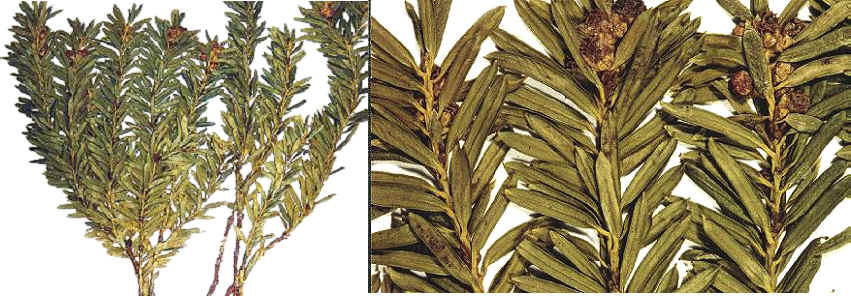 |
©The
World Botanical Associates Web Page
Prepared by Richard W. Spjut
April 2003
 |
|
16e.Taxus baccata var. ericoides Carrière (Figs. 136–137), Traité gén. conif. 519. 1855. Taxus baccata (f.) ericoides Beissner, Handb. Nandelholzk. 175. 1891. Original material and origin unknown. Neotype Proposed—Morocco: Ifrane 1700 m, Davis 49209 at BM! (with male cones, leaves on abaxial surface with 9 stomata rows/band, border of 5 marginal smooth cells, partly papillose midrib). Taxus baccata (var.) mitchelii. Carrière, Traité gén. conif. 518. 1855. Original material unknown, reported by Carrière to be similar to var. monstruosa or to a pygmy yew; described by den Ouden & Boom (1965) to have horizontal, sometimes ascending branches. Carrière (1867) treated it as a synonym of var. ericoides. Type undetermined. Taxus baccata (var.) miniata Carrière, Traité gén. conif. 736. 1867. Described as a small shrub with leaves sparse, linear, attenuate, and mucronate. Raised at Jardin des Plantes, Paris (den Ouden & Boom 1965). Original herbarium material and origin unknown, type undetermined. Taxus baccata var. microphylla Jacques ex Carrière, Traité gén. conif. 520. 1855. Original material unknown, type undetermined. Morocco yew. Distribution: Morocco. Apparently shrubs—with fastigiate, yellowish orange branchlets; persistent bud-scales conspicuous by their reddish brown color in contrast to the yellowish color of young branchlets; leaves radially disposed, pale green, oblong, ca. 1.5 cm long, 1.5–2 mm wide, obtuse, apiculate. Male cones maturing near apex of branchlets in subglobose aggregates; females cones unknown. Var.
ericoides is recognized only from the type. In horticulture, the
name has been applied to plants with a “dwarf” habit having
relatively small “ericoid” leaves.
A specimen at Kew, Murray 135 in adnot. T.
baccata ericoides from Masters, is perhaps indicative of
this variety in horticulture, but I regard this as belonging to
T. fastigiata var. nana.
|